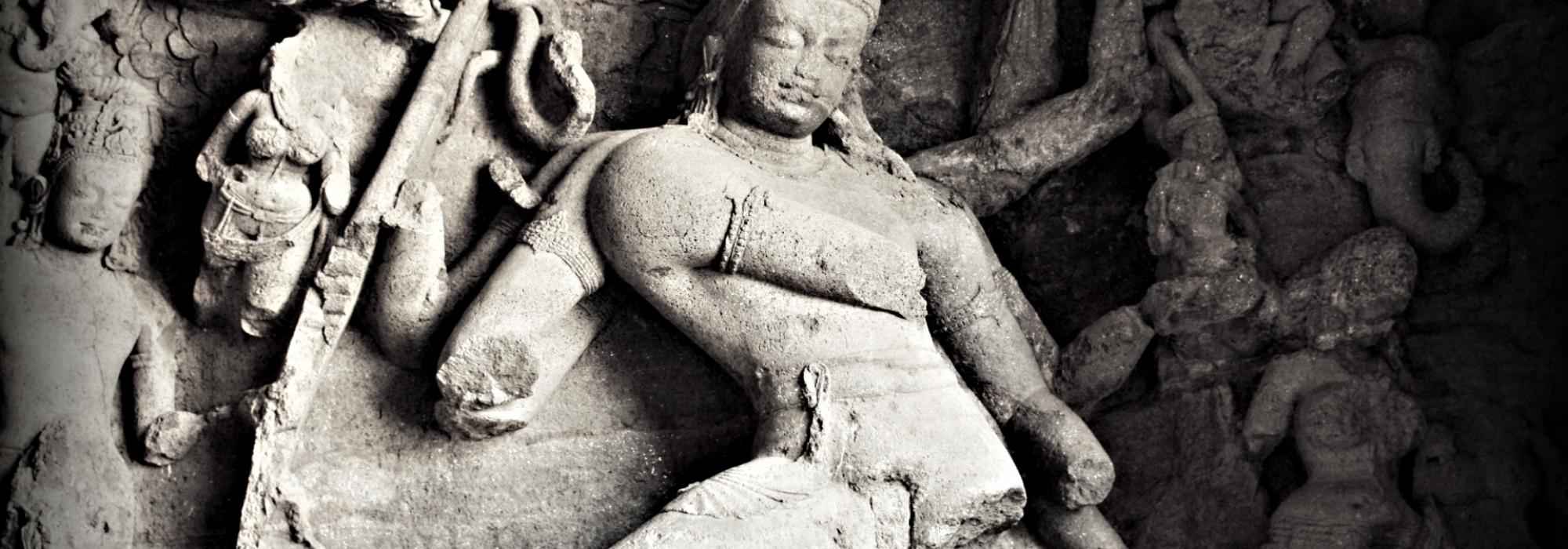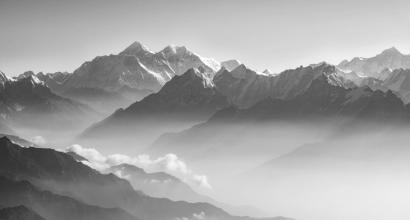Of late in classical dance performances, the proportion of nrutta, which lacks creative interpretation and expression, is on the rise. At the same time, rasabhinaya, i.e., aesthetic communication with creative interpretation of the lyrics and the music is decreasing.
[Note: 1. Bhavas are specific emotional states (chitta-vrutti) of a person. They are present in all people in the form of raga(love), dvesha (hatred) and so on. Rasa is the universalization of these bhavas, i.e., the emotional states of the people. The absolute Rasa is essentially Blissful in nature.
2. The art of communication employed by the artist to make his ideas known to the audience is called abhinaya. ‘Abhi’ means ‘towards’ (the audience), ‘naya’ is to ‘bring/take’, i.e., the artist bringing the aesthetic experience to the audience.]
This has indeed been a cause of displeasure to the connoisseurs. It is however a fact that it is difficult to learn rasabhinaya from a teacher and it is all the more difficult for a teacher to teach it to a student. Moreover, to present rasabhinaya in a performance and to impress the audience with the same is the most challenging part. It is probably due to the lethargy of dancers in practising and presenting good rasabhinaya that is has taken a back seat. The leaps and jumps which a dancer can employ for pure nrutta on stage gives an illusion that the dancer is agile and acrobatic, which can impress the lay audience just like they get impressed with a circus show. It is also easy to present a well-rehearsed jati on the stage. Having physical strength and capable limbs seem to be sufficient qualifications for such dancers. Thus, dance which has only nrutta based on calculated arithmetic patterns (‘lekkachara’) is mechanical and such performers can only be name-sake dancers. To add to this shortcoming of the dancers, the teachers too lack sensitivity for rasabhinaya and lack an imaginative mind to choreograph novel items for abhinaya. Their repertoire is thus limited to a few items. Moreover, the popular repertoires of such dancers has compositions of Muttuswami Dikshita, Tyagaraja, Svatitirunala, Jagannathadasa and Vachana-karas of Kannada, which are hard to adapt to abhinaya in dance. If not, a few stale and clichéd javalis would comprise their repertoire. Even if by chance they happen to pick a few good compositions, they fail to choreograph it in an aesthetic manner, thus failing to produce good quality rasabhinaya. Although these views are harsh, they are validated by my experience. There are several who have worked for the cause of good rasabhinaya and the current series of articles is one such attempt at reviving the tradition.
To teach rasabhinaya, training only in traditional jatis will not suffice. Experience in the ways of life and the world, a thorough reading of several works of classical literature and shastras are also essential. One must have a sensitive heart to provide learned appreciation for different classical art forms (This is called the भावयित्री प्रतिभा). With regard to Indian classical dance, a detailed study of works such as Abhinava-bharati of Abhinavagupta, Bhavaprakashana of Sharadatanaya, Rasarnavasudhakara of Singabhupala, Rasamanjari and Rasatarangini of Bhanudatta is required for a good understanding of the lakshana (the structure) of dance. For enrichment of the content, a study of literary works such as the Shakuntalam, Ratnavaḻi, Amarushatakaṃ, Srikriṣṇakarnamrutaṃ, Gitagovindam, Gahasattasayi is needed. To gain a good understanding of rasas other than shrungara, going through works such as Mudrarakshasaṃ, Mricchakatikaṃ, Uttararamacharitaṃ, Venisamharaṃ, Prabodhachandrodayaṃ will help. People who would like to have a more comprehensive understanding can include Kundamala of Dinnaga, Svapnavasavadattam of Bhasa, Meghadutaṃ and Kumarasambhavam of Kalidāsa in their reading list. All these are good picks from the corpus of classical Sanskrit literature. Selected portions of the works of Kannada poets such as Pampa, Ranna, Raghavanka, Kumaravyasa, Lakṣmisha would also be beneficial. The study of short poems of modern Kannada poets such as Kuvempu, Pu. Ti. Narasimhachar, K.S. Narasimha Swamy is also essential. While the suggested literature can cater to artists who have good background in Sanskrit and Kannada languages, similar works of classical literature are available in other regional Indian languages too. One need not be overwhelmed by the amount of reading expected of dancers, for classical dance mainly involves stylized expression (natyadharmi) and as rasabhinaya is primarily an exalted imitation of worldly emotions (भावानुकिर्तनं), knowledge of classical literature and the poetic conventions used (kavisamayas) is essential.
[Note: Lokadharmi is artistic imitation of the activities of the day to day world. Natyadharmi constitutes a set of gestures which are used by convention to communicate certain ideas in a theatrical performance. These need to be learnt by studying the shastras and cannot be picked up by observing the activities in the world.]
Kavisamayas can come in handy especially when an idea needs to be communicated concisely. For example, to distinguish between a lotus (kamala) and a water lily (neelotpala), both of which grow in a pond and both of which are among the five floral arrows of Manmatha one can make use of the poetic convention that the lotus blooms only when the sun shines and the water-lily blooms only when the moon shines. The dancer can first depict a pond through abhinaya, depict the sun in the sky using अलपद्म-हस्त and then pick up the lotus from the pond. Similarly, the moon can be established using अर्धचन्द्र-हस्त and it would then be clear that the flower that is picked from the pond is a water-lily. Further details can be found in the Natyashastra in the chapters on samanyabhinayam bahyopachara and chitrabhinaya. In addition to this, an artist must also closely observe the various aspects of nature, such as the seasonal flowering of trees, characteristics of animals and birds, the involuntary reactions of humans under different circumstances and so on. A peek into India’s rural life will give several ideas for adopting lokadharmi, such as drawing rangoli, milking of cows, churning of milk, knotting flowers to a garland and many more, the details of which one would miss if his observations of the worldly activities are not scrupulous enough.
The fundamental requirement for appreciating classical literature is a meticulous understanding of the pan-Indian culture. Therefore, a detailed study of the Ramayana and the Mahabharata and an understanding of the basic tenets of Indian philosophy is essential. Having a preliminary understanding of the outlines of temple sculpture, painting, agamas and basics of Indology can add value too. ‘Bharatiya-samskriti’ by Dr. S Srikanta Shastri and ‘Foundations of Indian culture’ by Dr. G.C. Pande can be referred for the same. Thus, only with a good understanding of the heart of Indian culture can one gain the skill to apply any work of literature for rasabhinaya.
The next important aspect is a good understanding of music. The dancer must be sensitive to the variety of rasas that a raga can give rise to and the rhythmic patterns (gati-bhedas) in different talas. An artist who is conscious about the various svara-patterns and the gamakas in a jati can easily adapt the movement of the limbs in nrutta to the music. The choreography and performance of Dr. Padma Subrahmanyam would serve as a great example for the same. The movements of her arms are higher up when the स्वर-सञ्चार is in the higher octaves and are lower otherwise. She even closely follows the jaru-gamakas (जारुगमक) by smooth movement of the limbs and the kampita-gamakas (कम्पितगमक) by oscillatory movement of the limbs, in the same rhythm. One must also be familiar with the language of the song for which choreography of abhinaya is done, at least to the extent that the different shades of meaning and the possible interpretations of the lyrics can be imagined by the artist. One must also be conscious of the meter (chandas) of the song, such that the metrical melody of the lyrics blends well with the rhythmic pattern of the tala. For a creative elaboration of the sanchari bhavas, an understanding of the alankaras used in the lyrics is essential. Also, for bringing about non-repetitive sancharis a creative mind and an expertise in naṭyadharmi is required too.
(The next installment will explain with an example how a song can be creatively interpreted in music and dance)
Translated from Kannada with additional notes by Arjun Bharadwaj



































